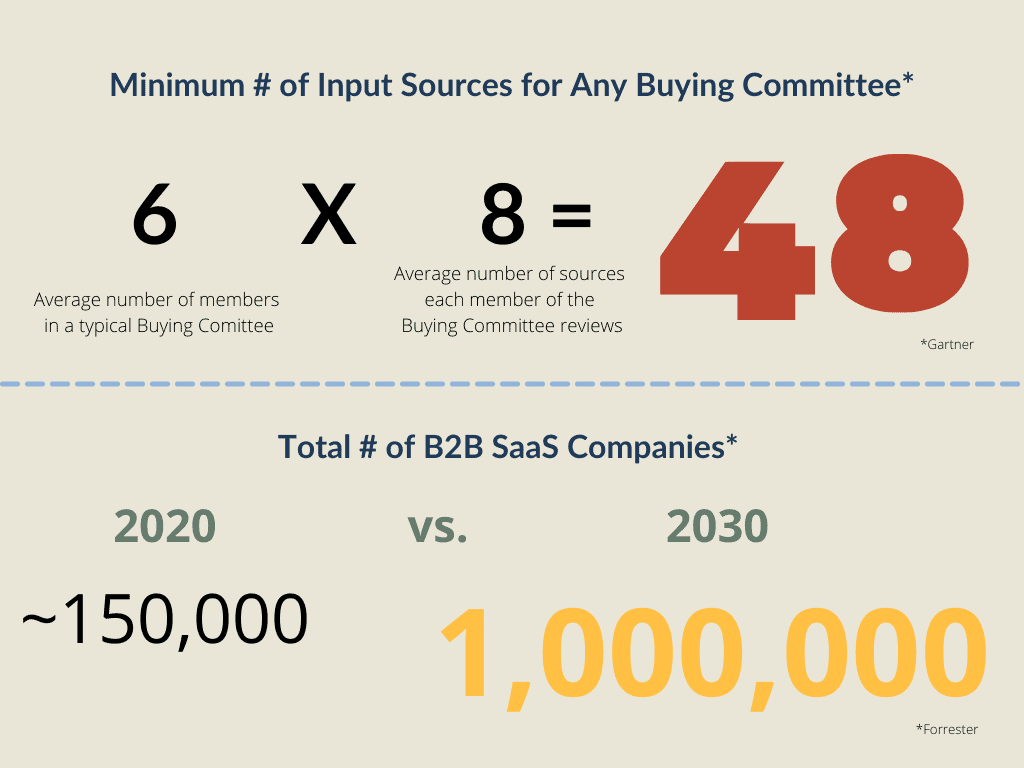According to Gartner, 44% of millennials – who now make up the largest demographic in the workforce, prefer a completely sales-rep-free environment when buying technology. Even before the pandemic, B2B buyers were already conducting over 80% of their research prior to engaging with a sales rep is a trend that has been accelerated by the pandemic as well. Work from anywhere, self-serve research before purchasing, and contactless buying journeys have all been sped up due to current circumstances.
In the past, it was industry standard for salespeople to build trust and relationships by meeting with a potential client face-to-face, wining and dining them from early in the buying process until the deal was closed. Now, the norm is the complete opposite: buyers want to research on their own further into the purchasing process before they engage with vendors directly. They want to take time to figure out exactly what their issue is and the best way to solve it. In the Avoiding the Sales Kill Box episode of the Rattle and Pedal: A B2B Marketing Podcast Maria Boulden, Gartner’s CSO Whisperer, said that the average business leader checks eight different sources before making a purchase decision. Self-serve education may seem like a smart way to buy technology without getting swayed by salespeople. But these purchases aren’t made in a vacuum by one person. Today’s complex technology purchases often have no less than six different key stakeholders come together, each with different business priorities, research, findings, and opinions. That means, at least 48 different input sources are presented in a Buying Committee meeting. It’s difficult to build consensus when everyone has to their own conclusion in a research silo.
What does self-serve education really mean for buying committees? Chaos.
Do you remember a time when someone else’s opinion completely derailed a decision you made? It’s like when you go to a restaurant: you are excited to try a chicken sandwich. Then, someone at the table tells you about how the last chicken sandwich they ate was disgusting (even though it wasn’t even from the same restaurant!). Someone else chimes in about how they heard from a friend that the fish is good here. You don’t really like fish, but now you find yourself looking at the menu again for an alternative.
What about a time when you were overwhelmed when given too many options for something? Let’s go back to that restaurant again. Do you typically make the best decision on what to eat when the menu is one page long, or when the menu is the size of a Russian novel? (I’m looking at you, Cheesecake Factory.)
A typical enterprise buying process is as follows:
- A business problem is identified.
- A group of people is tasked with solving the problem.
- The group sorts through online resources, personal and peer experiences, and expert opinions to set their requirements in order to find a solution.
- The new solution is compared to the current state.
- The solution is refined.
- Pricing is negotiated between multiple teams, such as IT, business unit leads, procurement, and the new vendors.
- The new solution is implemented and monitored to validate the purchase decision.
These steps aren’t linear or serial, and it’s difficult to know the downstream technical and operating interdependencies that come from prioritizing the wrong part of “the solution”. The road to a successful on-prem to cloud deployment is littered with “lift and shift” intentions. And if you circle back to challenge assumptions too late, you risk disrupting the momentum the team worked hard to get.
When buying committees self-serve, this is exactly what happens. To add to the mess, Forrester estimates there will be 1 MILLION SaaS companies by 2030, up from the current ~150K. Imagine how hard it is to try to review all of this information and compare it to way too many options while dealing with no alignment and consistent doubt on previous decisions. Confidence is lost, projects are stalled, and complex solutions that can solve a large problem are being dissected into smaller purchases that limit the business benefit of the purchase in the first place.
Wouldn’t it be nice to have someone who is completely agnostic but knows the industry well come in a sort through the chaos?
Am I about to go back to the restaurant scenario? You bet!
Whether the menu is small or large, how many times have you found yourself unable to decide between a few different entrees? You can indecisively waffle between options all you want. But if you ask the server for their recommendation? Since they know the menu, they can help narrow down your choices, and typically give you a few (delicious) options.
Working with a technology advisor is like asking a server what they recommend. Just like the server, the advisor wants what’s best for you and your experience. Just so you know, one in four tech buyers who refuse to work with a seller has buyer’s remorse. One in four!
So how does an advisor build alignment?
There are four key areas that are crucial to building alignment:
1. Business Drivers
While there are many reasons to undertake a technology transformation project, these reasons can typically fall under two categories. Either stakeholder is looking to buy a solution to solve an internal issue like cybersecurity risk, operating complexity, or a talent shortage. Other times, stakeholders want to use technology to achieve a competitive advantage in their industry, like increasing loyalty through a better Customer Experience. Whatever the drivers may be, team members need to make sure they’re working toward the same goal.
2. Economic Impact
When it comes to the total cost of ownership, teams should not only consider licenses and monthly fees, but also potential savings such as decommissioning on-premises servers or reduced time for on-boarding and training. There are costs involved with training, implementation, and maintenance of new technologies. Infrastructure like Network circuits and other auxiliary hardware can impact financials as well. Everyone wants to save money when purchasing a new solution. But understanding the economic impact of a project can be perplexing, especially when there is an expected business impact and budgets are changing departments (phone system = IT Expense, but CCaaS and CX software = Business expense).
3. Change Management
Some people think choosing what solution to purchase is the hard part. But the implementation of new technology is crucial for realizing the benefits of any new purchase. Applications need to be configured and integrated with business input. People need to be trained. Old technology needs to be decommissioned. New technology needs to be introduced in the most effective way possible. Oftentimes, these implementations involve new teams for both the buyer and the seller. Building consensus on the implementation and change management of a new technology is crucial for that technology’s success.
4. Operating Model
Large-scale technology transformations involve a huge amount of organizational change. What will the company look like after the new purchase is installed? Who’s responsible for the administration and support of the solution? Who will use it on a regular basis? How do they feel about this new solution? On the vendor side, what support will be offered once the technology is up and running? Failing to build alignment around these questions during the buying process can have catastrophic effects on the fate of a project.
This sounds difficult to manage.
It's true, it isn’t easy to build consensus among different teams. Internal politics and processes can make reaching alignment a tricky process. When you add in the chaos of sorting through the digital marketplace, it’s a wonder any projects get done at all. We find that many cloud technology purchases can take anywhere from nine to 18 months from beginning to end. Packaged applications and Infrastructure are especially difficult. The complexity of these solutions requires significant planning and implementing them into an existing IT environment can be a delicate and laborious process. Real-time applications have many interdependencies to unwind, assess and manage risks, and it takes some time to get it right. Investing in infrastructure is like investing in plumbing – if it’s working well enough, it’s out of sight and out of mind for executives and stakeholders outside of IT.
It makes sense why buyers feel trepidation about bringing a salesperson into this lengthy, difficult process. If the process is already risky, bringing in an unknown third party might seem even riskier. While a third party may help speed the process up, decision-makers often don’t think it’s worth the potential risk to a project.
How do I use third parties to sort through the chaos of buying technology?
First, bringing in a third party does not mean that the salespeople are not doing their job. On the contrary, in every product category, you might be shopping, there are many direct sales reps that have the skills and ability to make your purchase and experience easier. These types of reps are the ones who are client-focused rather than quota-focused. These individuals are highly influential within their organizations and can truly pave the path for a better customer experience.
A third party works for both the client and the seller. On one hand, we ensure that everyone on the client’s side is aligned and working together. On the other hand, we make sure that the sales rep from the vendor has all the right information to recommend and implement the right solution. It’s not about selling a product, but about making sure a client is confident in their decision to buy, implement, and manage an entirely new technical solution.
It’s not easy to build trust, especially with a buyer team that has dealt with misaligned goals, and the ongoing chaos of an ever-evolving digital marketplace. But at CXponent, we find that meeting clients where they are in the buying process is far more effective than just running them through the same sales cycle. Sometimes clients have their vendor decision complete but realize there’s risk in going into the deployment alone. Other times, clients have no clue where to start their buying process. In both cases, a third party can add value. By listening to the client and meeting them where they’re at, we help our clients sort through the chaos of buying technology.


.png)





